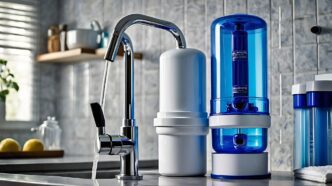A Quick Takeaway
The Story Behind the Trend
How to Make It Work for You
The Community View
Ensuring access to clean, healthy water is a fundamental aspect of a thriving home environment, impacting everything from your morning coffee to your daily hydration and even the longevity of your plumbing. For anyone concerned about the quality of their tap water, understanding and choosing the right home water filter is a crucial step toward mitigating potential contaminants and improving overall well-being. This guide will help you navigate the various options available, from simple pitcher filters to comprehensive whole-house systems, empowering you to make an informed decision based on your specific needs and water quality concerns.
Why Filter Your Home’s Water?
Tap water, while generally regulated, can still contain a variety of impurities depending on its source and the infrastructure it travels through. These can include chlorine, sediment, heavy metals like lead and copper, pesticides, industrial chemicals, and even emerging contaminants such as PFAS. Filtering your water not only removes these unwanted substances, safeguarding your health, but also significantly improves its taste and odor, encouraging greater hydration.
Consuming cleaner water can have numerous health benefits, reducing exposure to toxins that may accumulate in the body over time. Beyond personal consumption, filtered water can also extend the life of appliances by preventing mineral buildup and improve the quality of cooking and bathing experiences. It’s an investment in both your health and your home’s longevity.
Understanding Your Water Quality
Before selecting a filter, it’s essential to know what’s in your water. Public water utilities are required to provide an annual Consumer Confidence Report (CCR) detailing contaminant levels, but this report reflects general water quality at the source, not necessarily at your tap. Private well owners are solely responsible for testing their water.
Consider conducting a professional water test, especially if you suspect specific issues like lead pipes, hard water, or unusual tastes and odors. This test will pinpoint exact contaminants and their concentrations, guiding you toward the most effective filtration solution. Without this information, choosing a filter can be a shot in the dark, potentially leaving critical contaminants unaddressed.
Types of Home Water Filters
Pitcher Filters
These are the simplest and most affordable entry point into water filtration. Pitcher filters use activated carbon to reduce chlorine, taste, and odor, and sometimes light sediment. They are convenient for small households or individuals and require no installation, but they have limited capacity and slow filtration rates.
Faucet-Mounted Filters
Affixing directly to your kitchen faucet, these filters offer point-of-use filtration, providing filtered water on demand. They typically use activated carbon and often include a selector switch to toggle between filtered and unfiltered water. Faucet filters are easy to install, relatively inexpensive, and more effective than pitchers for daily drinking and cooking needs.
Under-Sink Filters
Installed beneath your kitchen sink, these systems connect directly to your cold-water line and often dispense filtered water through a dedicated faucet. Under-sink filters offer more robust filtration, frequently employing multiple stages of filtration, including activated carbon, sediment filters, and sometimes specialized media for specific contaminants. They provide a higher volume of filtered water and are more discreet than faucet filters.
Whole-House Filters
A whole-house filtration system, also known as a point-of-entry system, treats all the water entering your home. This means every faucet, shower, and appliance receives filtered water. These systems are ideal for comprehensive protection against chlorine, sediment, and other widespread contaminants, protecting your entire household and extending the life of your plumbing and appliances. Installation is more complex and typically requires a professional.
Reverse Osmosis (RO) Systems
Often integrated into under-sink setups, Reverse Osmosis systems provide a high level of purification by forcing water through a semi-permeable membrane. RO effectively removes a vast array of contaminants, including dissolved solids, heavy metals, fluoride, and many chemicals. While highly effective, RO systems are slower, produce some wastewater, and can remove beneficial minerals, often requiring a remineralization stage.
Distillation Systems
Water distillers boil water into steam, which then condenses back into liquid, leaving impurities behind. This method is highly effective at removing minerals, heavy metals, bacteria, and most chemicals. However, distillation is a slow process, energy-intensive, and also removes beneficial minerals, resulting in very pure but sometimes flat-tasting water.
Key Filtration Technologies
Understanding the core technologies helps in selecting the right filter:
- Activated Carbon: Excellent for removing chlorine, volatile organic compounds (VOCs), pesticides, herbicides, and improving taste and odor.
- KDF (Kinetic Degradation Fluxion): Often used in conjunction with carbon, KDF media can remove chlorine, heavy metals, and inhibit bacteria growth.
- Ceramic Filters: Effective at trapping sediment, bacteria, and cysts due to their microscopic pore structure.
- Ion Exchange: Primarily used in water softeners to remove hard water minerals (calcium and magnesium) by exchanging them with sodium ions.
- UV Sterilization: Uses ultraviolet light to kill bacteria, viruses, and other microorganisms, providing an extra layer of disinfection.
Choosing the Best Filter for Your Home
The “best” water filter is subjective and depends on several factors. First, prioritize the contaminants you need to remove based on your water test results. Second, consider your budget for both the initial purchase and ongoing filter replacements. Third, evaluate installation complexity and your willingness for DIY versus professional setup. Finally, assess the flow rate and capacity required for your household’s daily water consumption.
Look for filters certified by organizations like NSF International (National Sanitation Foundation) or the Water Quality Association (WQA). These certifications ensure that the filter performs as advertised and meets strict public health standards for contaminant reduction.
Maintaining Your Filtration System
Regardless of the system you choose, regular maintenance is paramount for optimal performance and water quality. This primarily involves timely filter replacements according to the manufacturer’s recommendations. Neglecting to change filters can lead to reduced effectiveness, decreased flow rates, and in some cases, can even allow trapped contaminants to leach back into your water. Adhering to the maintenance schedule ensures your system continues to deliver clean, healthy water reliably.
Empowering Your Hydration Choices
Investing in a home water filter is a proactive step towards a healthier lifestyle, offering peace of mind and tangible benefits for your well-being. By understanding your water quality, exploring the various filtration technologies, and considering your household’s specific needs, you can confidently select a system that provides consistent access to clean, delicious water. Make an informed choice today to elevate your hydration and overall health.








